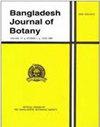Potent indigenous weeds for soil chromium remediation and public health risk assessment with pot-grown edible plants
IF 0.3
4区 生物学
Q4 PLANT SCIENCES
引用次数: 0
Abstract
Chromium, naturally present in trace amounts in the environment, poses a significant risk as both a carcinogen and a contaminant at elevated concentrations. The study explores the chromium accumulation potential of seven indigenous weeds of Hazaribagh, Bangladesh. It further investigates the threat and toxicity associated with vegetables, crops, and aromatic plant cultivation in chromium-laden soil. The study revealed that the study area contains alarmingly high levels of Cr (III), i.e., 2328–34,536 mg Cr/kg as demonstrated in a spatial GIS map. The weeds accumulated 27.8 – 2496.6 mg Cr/kg and 11.4 –506.9 mg Cr/kg in roots and shoots respectively. Among the seven weeds, Phyllanthus niruri, Cyperus sp., and Vernonia patula met at least one phytoremediation criteria and can be used for soil chromium remediation purposes. In the pot study, five species, Brassica nipus (mustard), Helianthus annuus (sunflower), Ocimum sanctum (holy basil), Capsicum annuum (green chili), and Abelmoschus esculentus (okra), were exposed to chromium (III) sulfate spiked soil for forty days at 100, 500, and 20000 mg Cr/kg soil concentrations. Green chili, sunflower, mustard, and okra demonstrated high chromium uptake in roots (13.3- 195 mg/ kg) and shoots (13.2-63.7 mg/kg) exceeding permissible and toxicity threshold for plants. These findings highlight the importance of not cultivating these species in chromium-contaminated areas. However, basil showed chromium tolerance by limiting the uptake in the shoot along with excellent growth reducing the risk of chromium transferring through the food chain, and therefore, is safe to grow in Hazaribagh for producing metal-free aromatic oil. Bangladesh J. Bot. 52(3): 875-882, 2023 (September)利用盆栽食用植物进行土壤铬修复和公共健康风险评估的有效本地杂草
铬天然存在于环境中的微量元素中,浓度升高时会产生致癌和污染的巨大风险。本研究探讨了孟加拉国 Hazaribagh 七种本地杂草的铬积累潜力。研究还进一步调查了在含铬土壤中种植蔬菜、农作物和芳香植物所带来的威胁和毒性。研究发现,研究区域的铬 (III) 含量高得惊人,如空间 GIS 地图所示,达到 2328-34,536 毫克铬/千克。杂草的根和芽中分别积累了 27.8 - 2496.6 毫克铬/千克和 11.4 - 506.9 毫克铬/千克。在这七种杂草中,Phyllanthus niruri、Cyperus sp.和 Vernonia patula 至少符合一项植物修复标准,可用于土壤铬修复。在盆栽研究中,五种植物,即 Brassica nipus(芥菜)、Helianthus annuus(向日葵)、Ocimum sanctum(圣罗勒)、Capsicum annuum(青辣椒)和 Abelmoschus esculentus(秋葵),被暴露在硫酸铬(III)浓度为 100、500 和 20000 毫克铬/千克的土壤中 40 天。青辣椒、向日葵、芥菜和秋葵的根部(13.3- 195 毫克/千克)和芽部(13.2-63.7 毫克/千克)对铬的吸收率很高,超过了植物允许的毒性阈值。这些发现凸显了不在铬污染地区种植这些物种的重要性。不过,罗勒表现出了对铬的耐受性,它限制了芽的吸收,同时生长良好,降低了铬通过食物链转移的风险,因此可以在哈扎里巴格安全种植,用于生产不含金属的芳香油。孟加拉国植物学杂志52(3):875-882,2023 年(9 月)
本文章由计算机程序翻译,如有差异,请以英文原文为准。
求助全文
约1分钟内获得全文
求助全文
来源期刊

Bangladesh Journal of Botany
生物-植物科学
CiteScore
0.80
自引率
0.00%
发文量
77
审稿时长
9 months
期刊介绍:
Bangladesh in situated on the north of Bay of Bengal. Climatically it is a humid subtropical country. Most of the land is deltaic plain of two great rivers, the Ganges and the Bhrammaputra and it tributaries. The country has rich diversity of plants. Main crops cultivated are Rice, Jute, Wheat, Maize, Sugarcane, Mustard and different kinds of Lentils. There are a good number of Public and Private Universities and Plant Research Establishments.
Bangladesh Journal of Botany is the official organ of the Bangladesh Botanical Society established in 1972. Since 1972 Bangladesh Journal of Botany is being published regularly. Two issues of the Journal are published, one in June and another in December.
Scientific papers (Full paper and short communication) on any field of Plant Sciences from anywhere in the World are considered for publication in Bangladesh Journal of Botany.
 求助内容:
求助内容: 应助结果提醒方式:
应助结果提醒方式:


